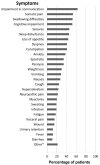Pediatric Patients Receiving Specialized Palliative Home Care According to German Law: A Prospective Multicenter Cohort Study
- PMID: 29857504
- PMCID: PMC6028915
- DOI: 10.3390/children5060066
Pediatric Patients Receiving Specialized Palliative Home Care According to German Law: A Prospective Multicenter Cohort Study
Abstract
In Germany, every child with a life-limiting condition suffering from symptoms that cannot sufficiently be controlled is eligible by law for specialized pediatric palliative home care (SPPHC). It is the aim of this study to describe the demographic and clinical characteristics of children referred to SPPHC and to compare patients with cancer and non-cancer conditions. The prospective multicenter study includes data on 75 children (median age 7.7 years, 50.7% male). The majority had non-cancer conditions (72%). The most common symptoms were cognitive impairment, somatic pain, impairment in communication or swallowing difficulties. Swallowing difficulties, seizures, and spasticity occurred significantly more often in non-cancer patients (p < 0.01). Cancer patients received antiemetics significantly more often (permanent and on demand) than non-cancer patients (p < 0.01). Significantly more non-cancer patients had some type of feeding tube (57.3%) or received oxygen (33.3%) (p < 0.01). Central venous catheters had been fitted in 20% of the patients, mostly in cancer patients (p < 0.001). Tracheostomy tubes (9.3%) or ventilation (14.7%) were only used in non-cancer patients. In conclusion, patients referred to SPPHC are a diverse cohort with complex conditions including a large range of neurologically originating symptoms. The care of pediatric palliative care patients with cancer is different to the care of non-cancer patients.
Keywords: cancer; home care; non-cancer; palliative care; pediatrics.
Conflict of interest statement
The authors declare no conflict of interest.
Figures
Similar articles
-
[Evaluation of Specialised Paediatric Palliative Home Care in Lower Saxony, Germany - A Qualitative Study on Parents' Perspectives].Gesundheitswesen. 2016 May;78(5):306-12. doi: 10.1055/s-0034-1390451. Epub 2014 Nov 14. Gesundheitswesen. 2016. PMID: 25397908 German.
-
"Let's Bring Her Home First." Patient Characteristics and Place of Death in Specialized Pediatric Palliative Home Care.J Pain Symptom Manage. 2017 Aug;54(2):159-166. doi: 10.1016/j.jpainsymman.2017.04.006. Epub 2017 Jun 8. J Pain Symptom Manage. 2017. PMID: 28602938
-
Did increased availability of pediatric palliative care lead to improved palliative care outcomes in children with cancer?J Palliat Med. 2013 Sep;16(9):1034-9. doi: 10.1089/jpm.2013.0014. Epub 2013 Jul 31. J Palliat Med. 2013. PMID: 23901834
-
Palliative Chemotherapy: Does It Only Provide False Hope? The Role of Palliative Care in a Young Patient With Newly Diagnosed Metastatic Adenocarcinoma.J Adv Pract Oncol. 2017 May-Jun;8(4):382-386. Epub 2017 May 1. J Adv Pract Oncol. 2017. PMID: 30018843 Free PMC article. Review.
-
Palliative care in children with cancer: which child and when?J Natl Cancer Inst Monogr. 2004;(32):144-9. doi: 10.1093/jncimonographs/lgh007. J Natl Cancer Inst Monogr. 2004. PMID: 15263058 Review.
Cited by
-
Out-of-Hospital Emergencies in Children Under Palliative Home Care.Front Pediatr. 2021 Dec 22;9:734181. doi: 10.3389/fped.2021.734181. eCollection 2021. Front Pediatr. 2021. PMID: 35004533 Free PMC article.
-
Participatory Design of a Medication Module in an Electronic Medical Record for Paediatric Palliative Care: A Think-Aloud Approach with Nurses and Physicians.Children (Basel). 2022 Jan 6;9(1):82. doi: 10.3390/children9010082. Children (Basel). 2022. PMID: 35053707 Free PMC article.
-
Evaluation of an Electronic Medical Record Module for Nursing Documentation in Paediatric Palliative Care: Involvement of Nurses with a Think-Aloud Approach.Int J Environ Res Public Health. 2022 Mar 18;19(6):3637. doi: 10.3390/ijerph19063637. Int J Environ Res Public Health. 2022. PMID: 35329323 Free PMC article.
-
Cardiopulmonary resuscitation in pediatric patients under palliative home care - A multicenter retrospective study.Front Pediatr. 2023 Jan 10;10:1105609. doi: 10.3389/fped.2022.1105609. eCollection 2022. Front Pediatr. 2023. PMID: 36704133 Free PMC article.
-
Gastrointestinal Symptoms in Children With Life-Limiting Conditions Receiving Palliative Home Care.Front Pediatr. 2021 Mar 31;9:654531. doi: 10.3389/fped.2021.654531. eCollection 2021. Front Pediatr. 2021. PMID: 33869119 Free PMC article.
References
-
- Beck C.H. German Social Law Order Book V–Public Health Sector. Volume 16. Deutscher Taschenbuchverlag; Munich, Germany: 2010. §37b.
-
- Schmidt-Wolf G., Elsner F., Lindena G., Hilgers R.-D., Heussen N., Rolke R., Ostgathe C., Radbruch L. Evaluation of 12 pilot projects to improve outpatient palliative care. Dtsch. Med. Wochenschr. 2013;138:2585–2591. - PubMed
-
- Heckel M., Stiel S., Frauendorf T., Hanke R., Ostgathe C. Comparison of patients and their care in urban and rural specialised palliative home care–A single service analysis. Gesundheitswesen. 2016;78:431–437. - PubMed
LinkOut - more resources
Full Text Sources
Other Literature Sources



